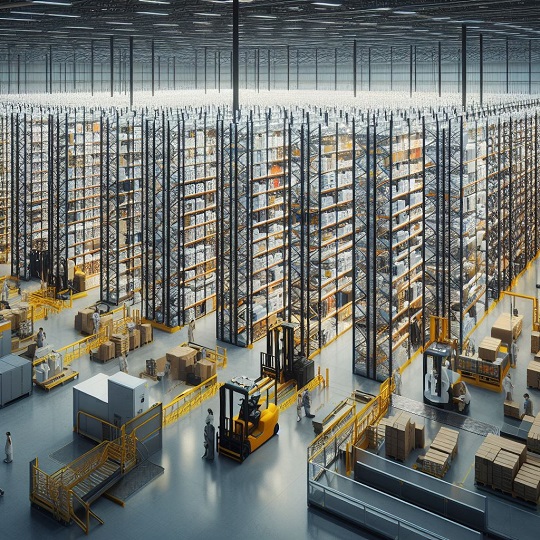In today’s fast-paced business landscape, optimizing warehouse operations has become more critical than ever. With increasing customer demands for faster deliveries, greater accuracy, and cost-efficiency, many companies are turning to automation to stay competitive.
But how do you know when it’s the right time to automate your warehouse?
In this comprehensive guide, we’ll explore the key factors and considerations that decision-makers should weigh when contemplating warehouse automation.
By the end of this article, you’ll have a solid understanding of when and how to make the leap into warehouse automation.
Before we go further into this topic, don’t forget to follow my LinkedIn account. You’ll get more helpful insights on supply chain management there.
Table of Contents
Understanding the Need for Warehouse Automation
Warehouses are the backbone of many businesses, serving as hubs for storing, picking, packing, and shipping products to customers.
To remain efficient and cost-effective, businesses must recognize the signs that indicate it’s time to automate their warehouse operations.
Volume and Growth
One of the most compelling reasons to consider warehouse automation is a sustained increase in order volumes.
As your business experiences growth, your manual processes may struggle to keep up.
Frequent shortages, order errors, and long lead times can be symptoms of a capacity problem.
Automated systems are designed to handle high volumes efficiently, making them a strategic choice for growing businesses.
Labor Costs
Labor costs are a significant factor in warehouse operations. Assess the costs associated with hiring, training, and retaining manual labor.
High turnover rates can further disrupt your operations. Compare these expenses to the initial investment and ongoing maintenance costs of automation.
Automation may yield cost savings in the long run, as it reduces the reliance on a large labor force.
You might also like:
- How to Conduct Red Tag Activities in Your Warehouse
- How to Strike a Balance: Automation vs. Human Power in the Supply Chain
Efficiency and Accuracy
Efficiency and accuracy are crucial aspects of warehouse operations. Manual processes can be prone to errors and inefficiencies that impact your bottom line.
Accuracy
Manual picking and packing can lead to order errors, resulting in costly returns and customer dissatisfaction.

Automation systems, equipped with precision technology, can significantly improve order accuracy. Fewer errors mean fewer returns, fewer refunds, and happier customers.
Efficiency
Automated systems are designed for speed and efficiency. They can handle repetitive tasks, such as sorting, stacking, and transporting goods, much faster than humans.
This not only increases throughput but also reduces labor fatigue and the risk of injuries associated with manual handling.
Seasonal Fluctuations and Scalability
Seasonal peaks in demand can pose challenges for businesses that rely heavily on manual labor. Warehouse automation can offer a solution to efficiently scale your operations during busy periods.
Seasonal Peaks
Consider whether your business experiences seasonal fluctuations in demand.
During peak seasons, an automated warehouse can quickly adapt to increased order volumes without the need to hire and train temporary staff.
This flexibility ensures that you can meet customer demands even during the busiest times of the year.
Scalability
Scalability is a crucial factor when deciding to automate your warehouse. Your automation solution should be flexible enough to grow with your business.
This adaptability ensures that you can continue to meet your evolving needs without significant reinvestment in new equipment or systems.
ROI Calculation
Investing in warehouse automation is a significant financial decision. To make an informed choice, you need to calculate the expected Return on Investment (ROI).
Upfront Costs vs. Long-term Savings
While the initial investment in automation can be substantial, it’s essential to compare these upfront costs to the long-term savings and increased productivity.
Consider not only the reduction in labor costs but also the potential for improved accuracy, reduced errors, and increased customer satisfaction.
Ongoing Expenses
In addition to upfront costs, take into account the ongoing expenses associated with automation. This includes maintenance, energy consumption, software updates, and training for your staff. Understanding these ongoing costs is crucial for an accurate ROI assessment.
You might also like:
- How to Maximizing Shelf Life for Food Manufacturers
- Safeguarding Your Inventory: Detecting and Preventing Manipulation
Technology Advancements and Competitive Pressure
The field of warehouse automation is continually evolving. Staying informed about technological advancements and competitive pressures in your industry is essential.
Technology Advancements
Technology is advancing rapidly in the world of warehouse automation. New innovations, such as robotics, artificial intelligence, and advanced software, are making automation more affordable and efficient.

Keeping abreast of these developments can help you make more informed decisions about when and how to automate your warehouse.
Competitive Pressure
Consider the competitive landscape in your industry. If your competitors are automating their warehouses to gain a competitive edge, it may be necessary for you to do the same.
Falling behind in automation can put your business at a disadvantage in terms of efficiency and cost-effectiveness.
Expertise and Support
Implementing and maintaining warehouse automation systems requires expertise. Evaluate whether you have the necessary knowledge in-house or access to external support.
In-house Expertise
Assess your team’s expertise in warehouse automation. Do you have staff members who understand the technology and can manage its implementation and maintenance? If not, consider the need for training or hiring experts in the field.
External Support
Alternatively, you may opt to work with external partners or consultants who specialize in warehouse automation.
These experts can provide valuable guidance, ensure a smooth implementation process, and offer ongoing support for your automated systems.
Regulatory Compliance and Risk Management
When automating your warehouse, it’s essential to consider regulatory compliance and manage potential risks.
Regulatory Compliance
Ensure that any automation solutions you consider comply with industry regulations and safety standards. Non-compliance can lead to legal issues and disruptions in your operations.
Risk Management
Identify potential risks associated with automation, such as technology failures, cybersecurity threats, and unexpected downtime. Develop contingency plans to mitigate these risks and ensure the continuity of your warehouse operations.
Customer Expectations
Customer expectations are continually evolving, with demands for faster deliveries and real-time order tracking becoming the norm. Automation can help meet these expectations more effectively.
Fast Deliveries
Customers expect fast deliveries, and automation can significantly reduce order processing and fulfillment times.
Automated systems can pick, pack, and ship orders with remarkable speed, improving your ability to meet tight delivery deadlines.
Real-time Order Tracking
Automation often comes with sophisticated tracking and monitoring capabilities. This allows you to provide real-time order tracking to customers, enhancing their experience and building trust in your brand.
Conclusion
Deciding when to automate your warehouse is a complex decision that involves careful consideration of various factors.
By evaluating your current needs, growth projections, cost structures, and technological advancements, you can determine the right time to make the leap into warehouse automation.
Keep in mind that warehouse automation is not a one-size-fits-all solution, and the specific needs of your business should drive your decision-making process.
With the right approach, automation can lead to improved efficiency, accuracy, and competitiveness, ultimately benefiting your bottom line and customer satisfaction.
I hope you find it helpful!
Please share this article with your colleagues so they can also benefit. For more insights on supply chain management, follow my LinkedIn account. You’re free to use all articles on this blog for any purpose, even for commercial use, without needing to give credit.
 by
by 

